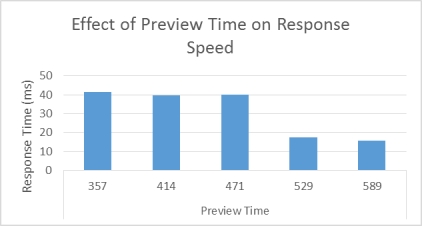Use the following to answer questions
Scenario I
Scenario I is based on fabricated data inspired by the following study:
Warner, C. B. & Jackson, J. D. (2009) . A time course examination of the preview effect: older adults need a longer preview than younger adults. Experimental Aging Research, 35, 327-347.
Preview Time and Aging
The purpose of this experiment was to determine the minimum preview time required for adults to make a fast perceptual decision. Young adults and older adults were presented visual stimuli for 357, 414, 471, 529 or 586 milliseconds (ms) . Knowing that older adults are more sensitive to cool temperatures, the researchers increased the temperature of the room to 75 degrees for the older adults (the temperature of the room for younger adults was 68 degrees) at the request of the IRB. The visual stimulus was presented on a computer monitor and contained several letter Ls rotated at various degrees. After the preview stimulus the participants were shown the test stimulus. This contained the Ls in the preview, as well as several additional Ls and one letter T. The participants were instructed to locate the "T" and were given 5.5 seconds to do so. This procedure was repeated several times such that each participant received 360 trials. The results indicated that younger adults located the T more quickly than the older adults regardless of preview time. Among the younger adults, preview time significantly affected their ability to locate the T. Specifically, they were more quickly able to identify the T when the preview time was 414 ms or 586 ms. The results indicate that preview time significantly affects perceptual discrimination and are illustrated in Figure 1.
 Figure 1. Participants responded significantly faster to visual stimuli when they were given 529 ms or 589 ms to preview the stimuli.
Figure 1. Participants responded significantly faster to visual stimuli when they were given 529 ms or 589 ms to preview the stimuli.
-(Scenario I) If there are 100 older adults and 100 younger adults in the study described in Scenario I, and adults in each age group are equally distributed across the five preview conditions, then there are _____ participants in each preview condition.
Definitions:
Human Capital
Represents the skills, knowledge, and experience possessed by an individual or population, viewed in terms of their value to an organization.
Floats And Transfers
Deals with the management of employee relocation or assignments to different positions or departments within an organization, often for short-term projects or to fill temporary vacancies.
Canadian Human Rights Acts
A set of laws in Canada aimed at preventing discrimination and ensuring equal treatment for all, regardless of race, religion, gender, etc.
Human Resource Planning
The process of forecasting an organization's future human resource requirements and devising strategies to meet those needs, including staffing and development.
Q6: The use of an overall score on
Q26: Dr. Raqui computed a two-way factorial analysis
Q27: Tyrese noticed in his undergraduate research lab
Q27: If you were presented with the following
Q68: (Scenario I) Suppose the researchers in Scenario
Q80: _ is a statistical test in which
Q92: In a 5 × 3 × 2
Q102: Dr. Soto was conducting research in a
Q107: Individual differences are handled in between-subject designs
Q142: (Scenario III) Suppose the researchers described in